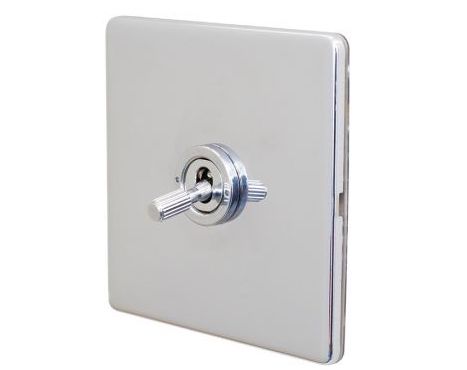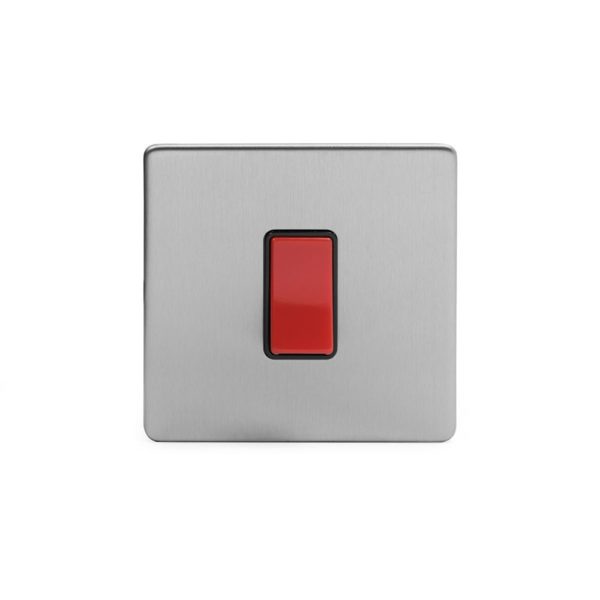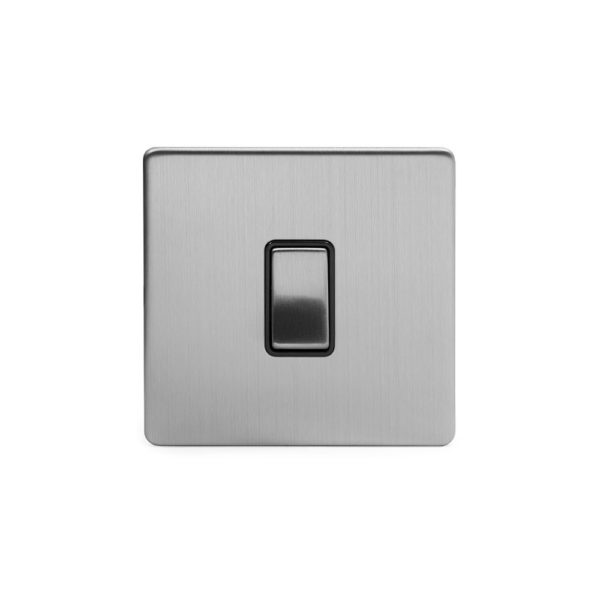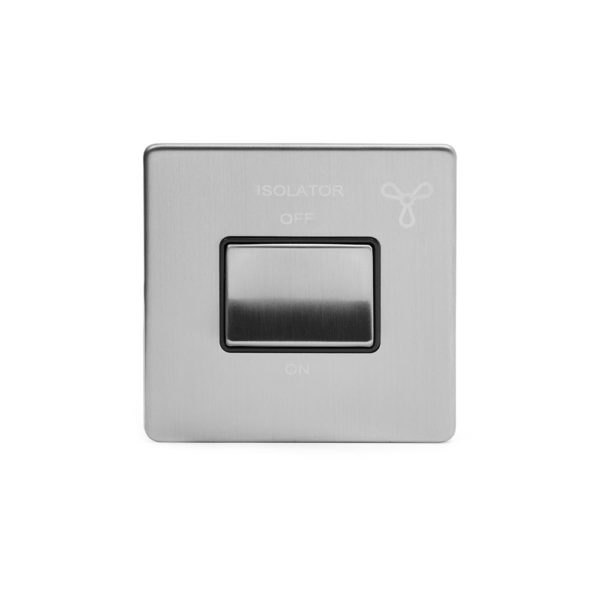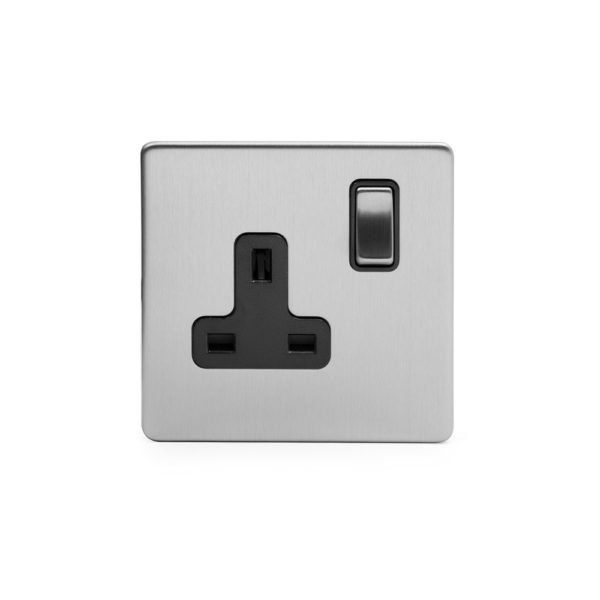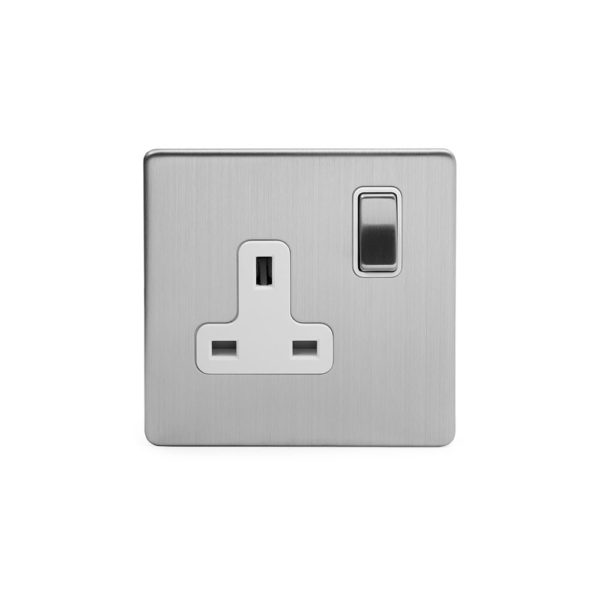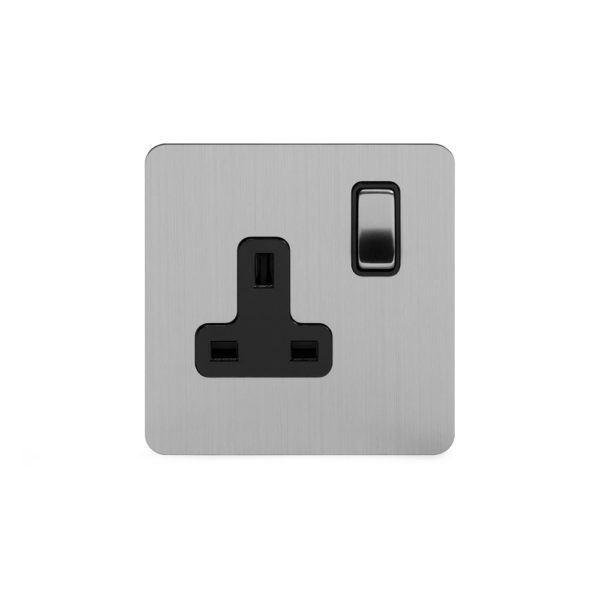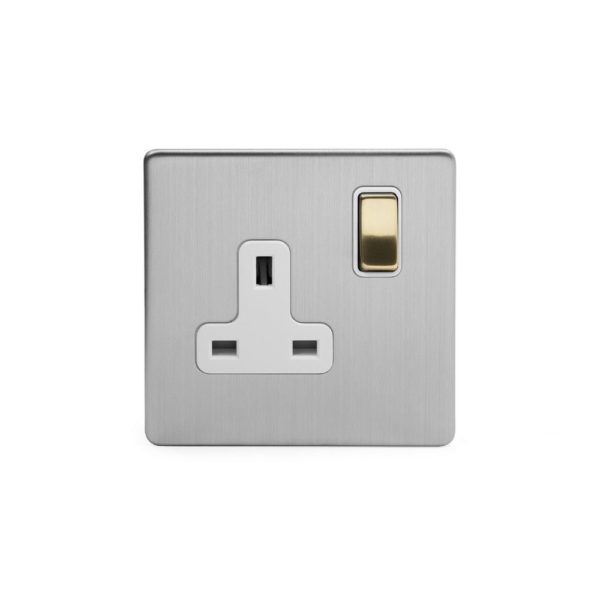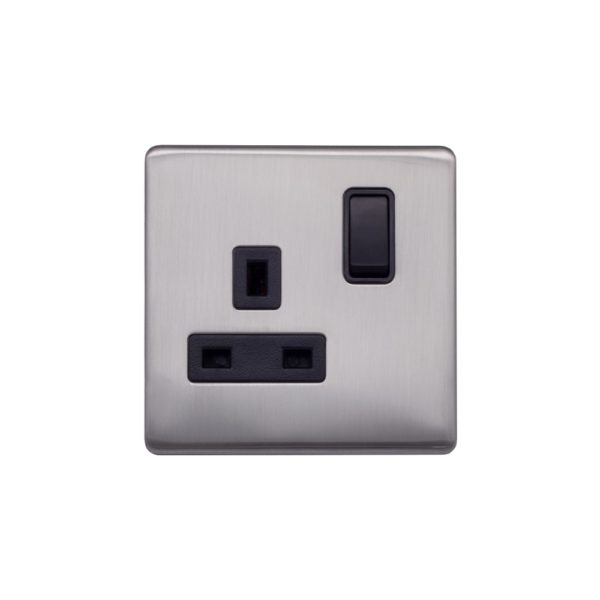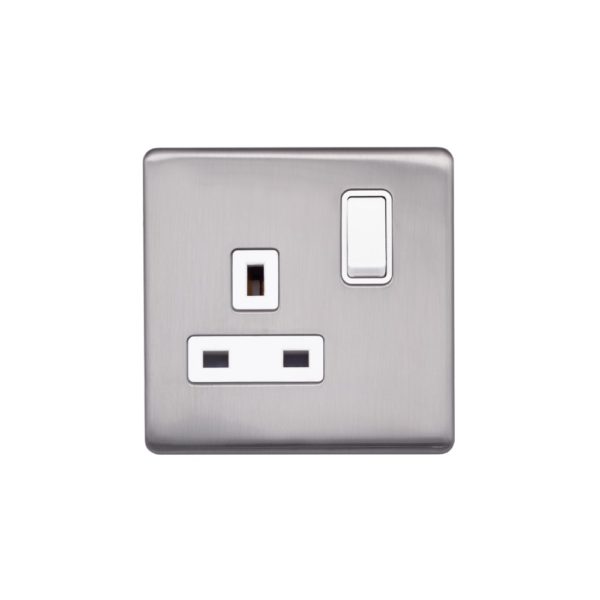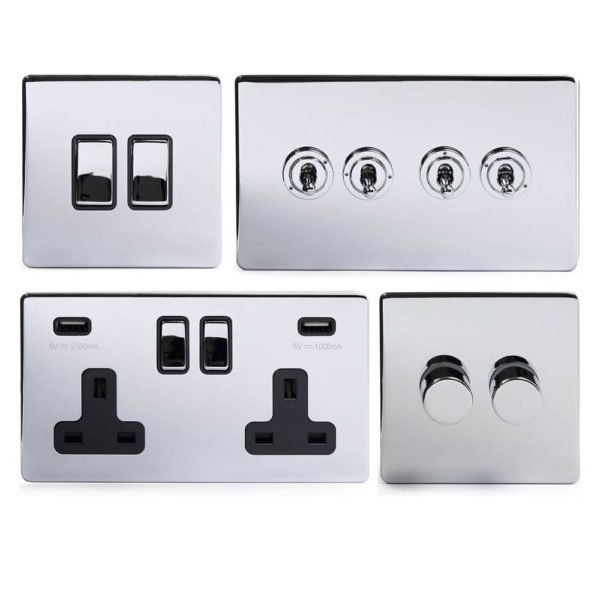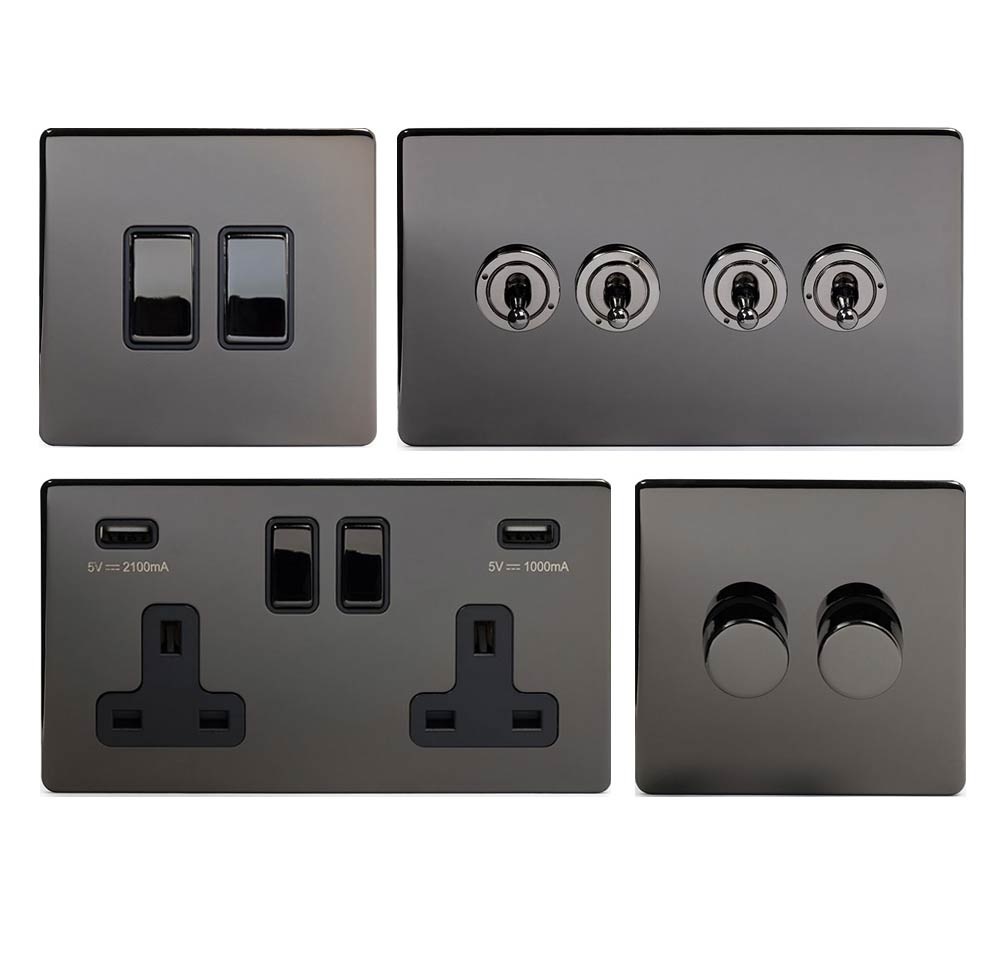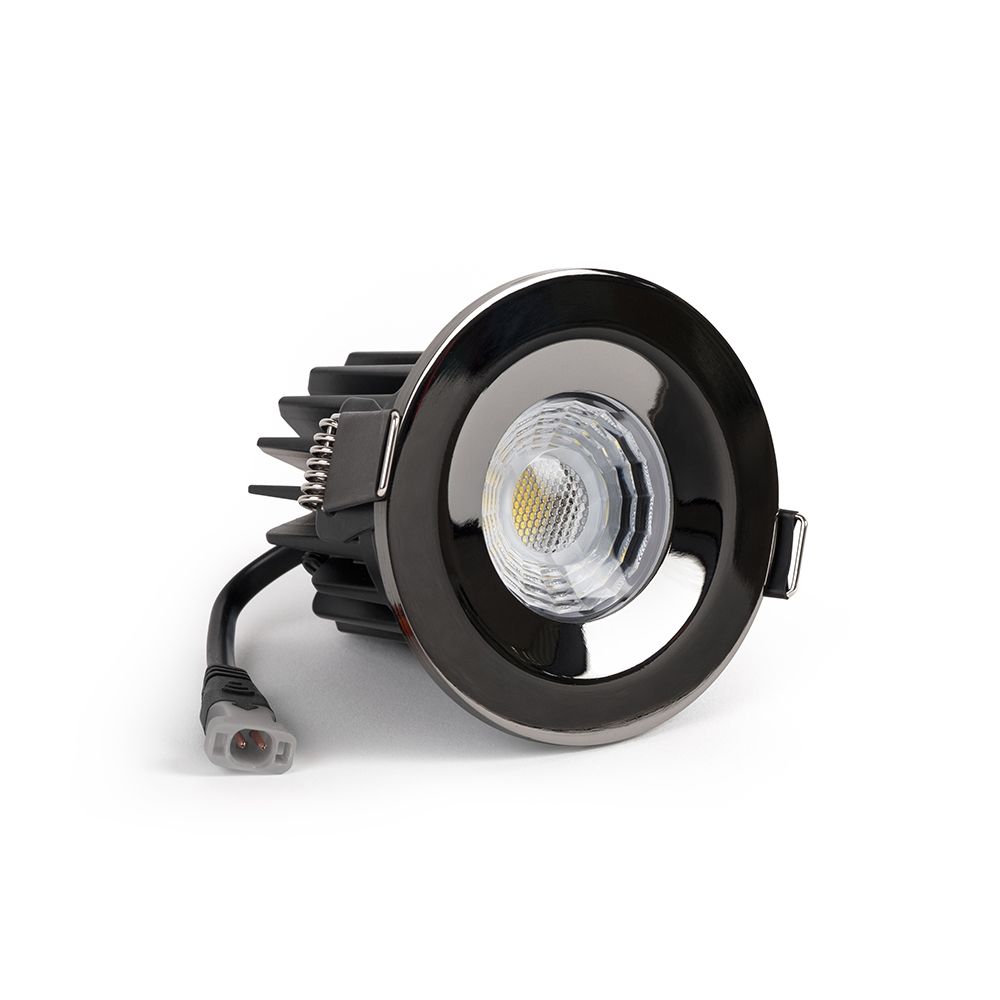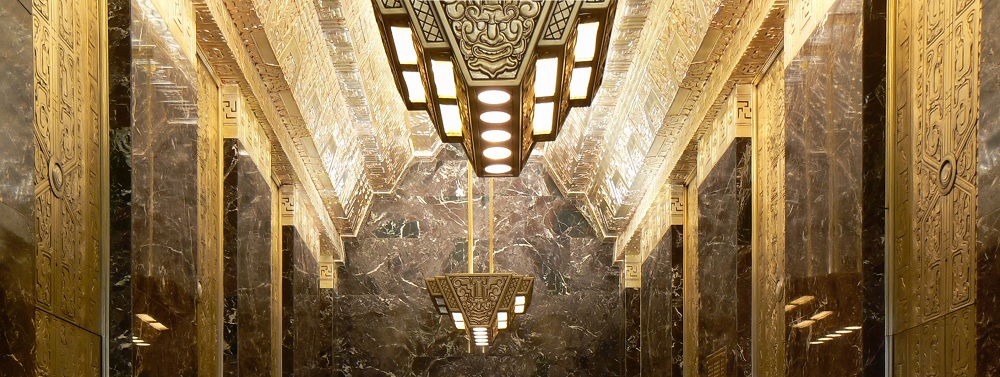
The instantly recognisable predominant decorative art style of the 1920s and 1930s, Art Deco is characterised by delineated geometric shapes, decadent detail work and rich colours. The style has been brought back into mainstream media in recent years with films such as The Great Gatsby really bringing the era to life.
Originally a French style (Art Deco being short for Arts Décoratifs) it has appeared all over the world, including in some famous New York 20th century buildings as well as hotels and luxury apartments.

While many home owners may find Deco a little overwhelming for a relaxing environment, it is also common to incorporate parts of the décor style by adding streamlined shapes in the form of angular furniture, instantly recognisable picture frames, and beautifully designed lighting.
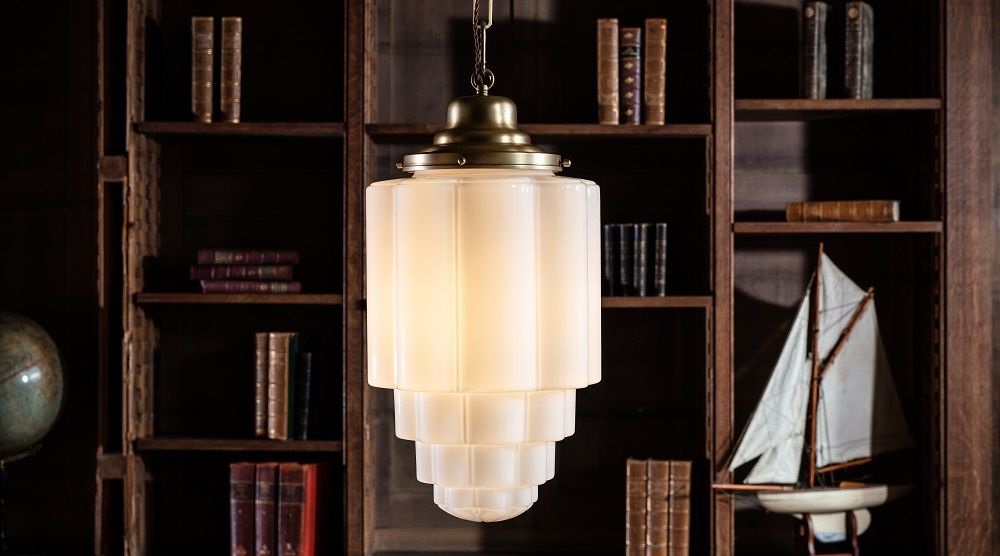
The glasshouse opal brass pendant light brings injects plenty of style into a room, with geometric shapes.
One key part of the room, which is occasionally an overlooked part of an Art Deco project is sockets and switches. These take up a relatively small amount of space, but a cheap looking white plastic switch in an otherwise beautifully designed and laid out Art Deco style apartment, home, or room, can ruin the overall appearance.
What socket and switch finish suits Art Deco?

To answer this question, we need to look at a common feature of Art Deco. Many beautifully designed Art Deco spaces have mirrors. The mirrors not only serve a function but they also add to the overall aesthetic. Often framed or shaped with geometric lines, they truly make a statement.
The mirror-like finish of a polished chrome switch perfectly suits Art Deco decors. Whilst a brushed chrome finish may look too warm and soft, polished chrome adds a clean crispness that really adds to the overall look of the room, without stealing the attention.

There may be a temptation to choose extravagant Deco style switches, however this would risk pulling the focus away from the rest of the room. Sockets and switches tend to work well subtly, rather than as a centrepiece. Try matching them with the nickel glasshouse pendant light as well as various Art Deco accents in the form of vases and lamps.
Toggle switches and dimmer knobs
Toggles bring an authentic vintage twist to any switch, however dimmer knobs don't always match with interior design styles such as Art Deco.
With our range of knurled toggles and dimmer knobs, these design assets match more seamlessly with your interior, offering a contrast in textures to highlight the polished shine of the switch plate. These stunning Art Deco toggles and knobs are available with our polished chrome plates, as well as matte black for a distinctly modern Art Deco fusion.
See our selection of polished chrome sockets and switches below as well as our art deco style pendant lights.
[related_products is_auto_added="1"]The instantly recognisable predominant decorative art style of the 1920s and 1930s, Art Deco is characterised by delineated geometric shapes, decadent detail work and rich colours. The style has been brought back into mainstream media in recent years with films such as The Great Gatsby really bringing the era to life. Originally a French style […]
Pendant lights above a kitchen island or breakfast bar not only add style to the whole room, but they provide a good level of the right sort of light for eating and other kitchen related tasks. They also tie the room together as a social space, not just a food preparation area.

Lighting a kitchen is much more complicated than simply putting a couple of downlights in the ceiling. With so much going on in modern kitchens, different parts of the rooms require different lighting for different tasks. For example, task lighting, such as LED strip lighting under cabinets, over worktops needs to be bright and daylight white, to make it easy to see what you are doing, however lighting over social areas needs to be less white, for a relaxing feel, and ambience.
Plan Your Kitchen
When planning your lighting above a kitchen island, it is worth considering the style of the light fixture. If you are going for a nautical style in your kitchen, a set of contemporary style pendant lights would look out of place.

Match Your Colour Palette
Nautical style kitchens tend to look fairly light in colour, with wood or metal finishes. You may choose, for example a heavy wooden work surface. This would bring a natural look and feel to the kitchen, so an ultra-contemporary pendant light above it wouldn’t fit with the style.
Solo Light vs Rows
Try a row of pendant lights above your kitchen island. This allows for multiple light sources, and reduces the amount of shadows. The number of pendant lights, and the distance between them depends a lot on the size of the pendants. You don’t want the space to look too clustered, but equally, you don’t want it to look too sparse.
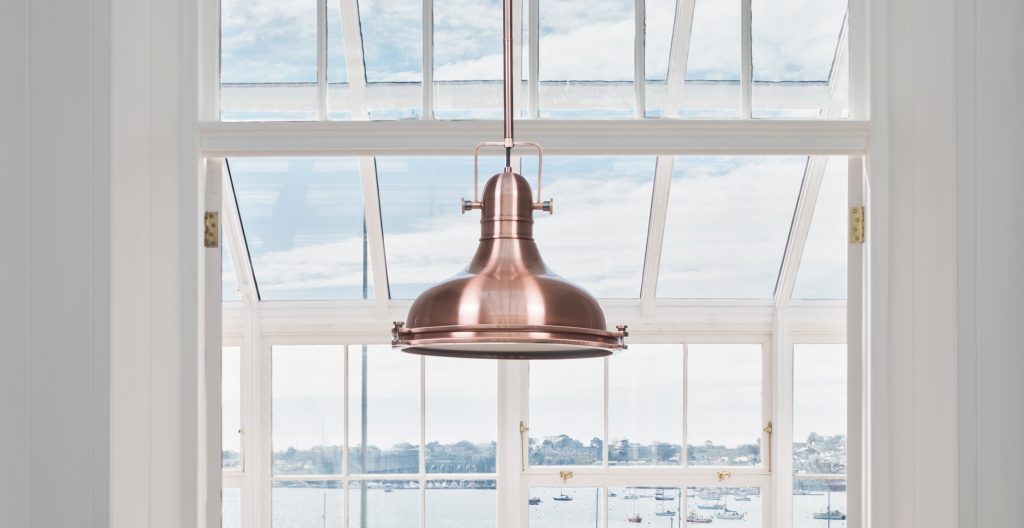
This beautiful rose gold pendant light really suits a nautical style kitchen. The shape really looks like a ship-style light, and the soft rose gold colour not only fits in with the nautical theme, but it also gives off a beautiful, calming shine. This pendant would perfectly complement rose gold taps, pots and pans too.
If you wish to add wall lights to your kitchen, there are plenty of styles to choose from, but for a truly nautical feel, bulkhead wall lights are ideal. These can add multiple light sources, whilst adding to the overall look of the room.
See our selection of nautical style pendant and wall lights below.
[related_products is_auto_added="1"]Pendant lights above a kitchen island or breakfast bar not only add style to the whole room, but they provide a good level of the right sort of light for eating and other kitchen related tasks
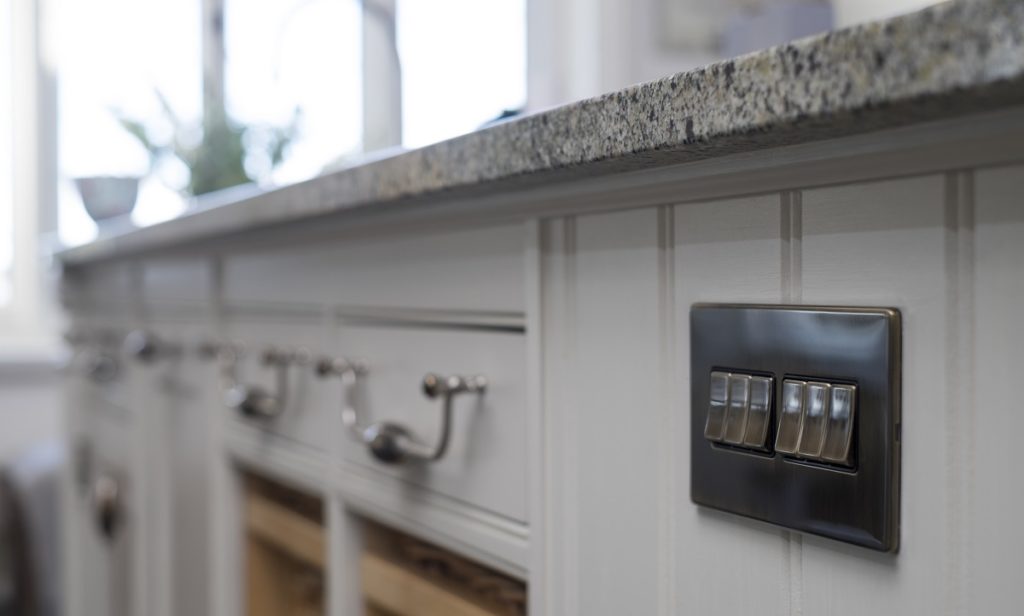
When completing a home renovation, you may find yourself in a situation in which you need to choose which light switch to use in each room. If you are looking into lighting for the first time, you may find that there are a multitude of switch types out there on the market, but many of them will be unsuitable for your needs.
There are two main areas to think about; function and appearance. In this article we will cover both areas and will help direct you towards the light switch that you need.
Switch Function:
Double Pole or Single Pole?
You may have seen double pole switches available to purchase, as well as single pole switches. Single pole switches are the most common type of light switch controlling just one circuit, while a double pole switch can control two circuits. So, a double pole switch is almost like having two single pole switches, controlled by the same switch. Double pole switches are generally best for appliances, so if you are looking for a straightforward light switch, you can choose a single pole, which tends to be cheaper than double pole. Read more about the differences between single pole and double pole switches.
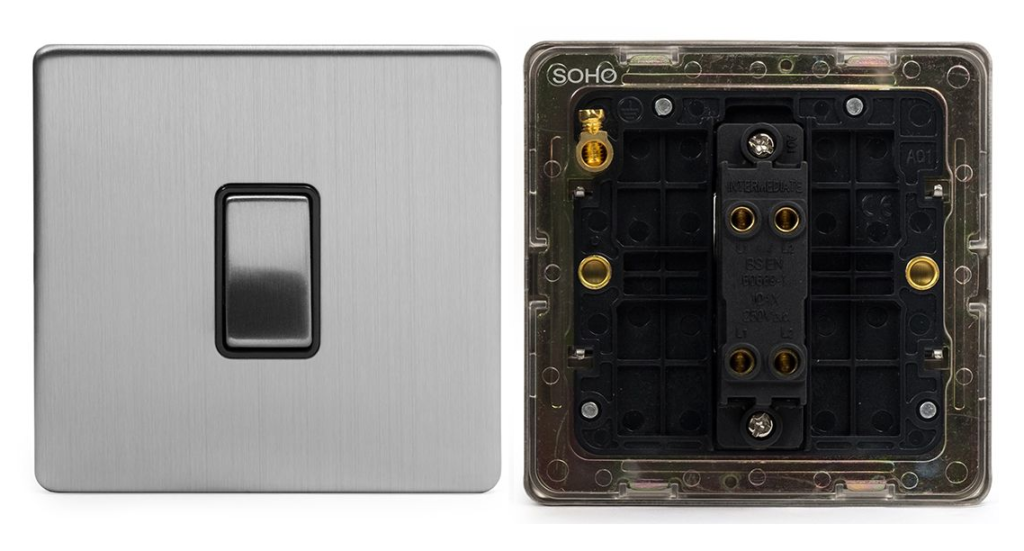
1-Way, 2-Way, or Intermediate?
When you have one switch controlling one light, you can use a 1-way switch. When two switches control that light, you need a 2-way. If you have three switches controlling the light, for example one on the ground floor, at the bottom of the stairs, one on a landing half way up the stairs and another at the top of the stairs, the middle one (half way up the stairs) will need to be an intermediate switch. Read more about intermediate switches.
Grid Switches
If you need to have different switch types on one plate, for example a 2-way switch alongside an intermediate switch, or a 2-way rocker switch on the same plate as a dimmer switch, grid switches can be the best solution. These switches allow you to create your switch using plates, frames and modules. This is the best way to get bespoke switches that match the appearance of the other sockets and switches in your home, without spending too much. Read more about grid switches.
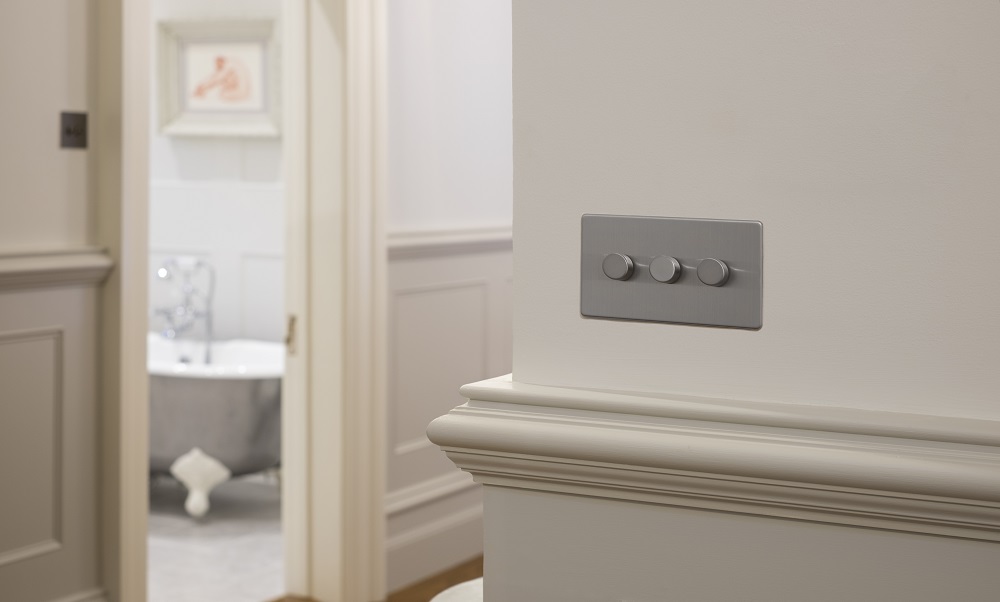
Dimmer Switches
Simply put, if you want to be able to dim your lights, you’ll need a dimmer switch. Dimming gives you the option of setting the mood and lighting level, to suit the time and situation. The main options are trailing edge and leading edge. If you wish to dim LED bulbs, then it is best to use a trailing edge dimmer. These are more expensive than leading edge, but a good trailing edge dimmer will also help with the longevity of the bulb.
Retractive switches
Retractive switches have become more common recently due to smart homes. These are switches that retract, so you can press, and it goes back to its original position. These tend to be more expensive than regular 1-way or 2-way switches, however, with a retractive switch you are able to dim lights as well using a dimming toggle module, or wiring it through to our smart dimmer.
Outdoor Switches
Another consideration for your home is exterior switches. If you desire to control your outdoor lighting from the outside of your home, you will need a switch with something called an IP66 rating. An IP rating gives you all the information you need for how weatherproof an electrical fitting is. The first number relates to dust and debris, and the second number determines how water resistant the device is. The higher the numbers, the more weatherproof. For outdoor light switches, we recommend no less than IP66 for your own safety.
You can have an IP66 rated outdoor switch, or a regular switch encased inside an IP66 casing, but what is the difference? Well, the outdoor switch is one that you can use without lifting the casing to access the switch, making this the most practical solution to outdoor lighting, for areas that require quick access.
The enclosed switch requires you to lift a panel to access the switch. This allows you the choice between a rocker switch and a dimmer switch, a great solution for more atmospheric exterior lighting. Simply click the box open to access the switches and click shut once more to protect it from the weather. The added benefit of this, is you can choose your own finishes if you prefer!
Appearance:
Toggle or Rocker switch
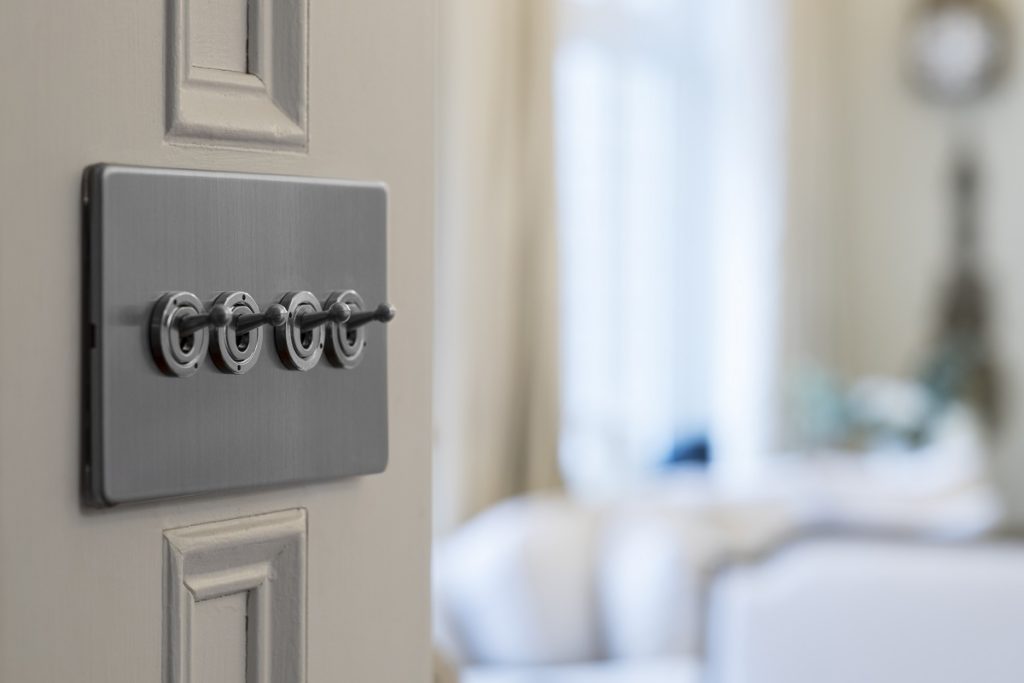
Both rocker switches and toggle switches operate in the same way, as they both have a regular on/off function. Toggle switches do, however tend to offer a slightly louder “click” sound when switched on or off, compared to rocker switches. The main difference between the two is the appearance. Read about the differences between toggle switches and rocker switches.
Light Switch Finish
There are plenty of different finishes on the market including brushed chrome, polished chrome, satin chrome, brushed steel, satin steel, brushed brass, polished brass, antique brass, black nickel, rose gold, copper, bronze, white metal, matt black and more. Each finish suits a different style, for example white is a clean look, black nickel is very contemporary, antique brass is classic or period, brushed chrome and polished chrome are very versatile, however polished chrome looks great in an art deco setting.
The other key factor to consider is the other colours in the room. Look at the door handles, appliances, cupboard handles and other metallic or plastic parts, and try to get them all matching. This is often overlooked by many people, but can really make a room look so much better. Read more about matching switches and sockets to interior design styles.
FAQs
DP switches (double pole switches) are switches that can control two circuits, as opposed to single pole switches (SP switches) that can control one circuit. You can find out more in our blog: Single Pole Vs Double Pole Switches.
Flat plates are light switches and sockets that have less depth on the plate. These tend to look more slick than raised plate sockets and switches, however it is not always possible to install them (the wall needs to be completely flat). Some manufacturers charge more for flat plate too.
When completing a home renovation, you may find yourself in a situation in which you need to choose which light switch to use in each room. If you are looking into lighting for the first time, you may find that there are a multitude of switch types out there on the market, but many of […]
Dimmer switches allow you to adjust your lighting to the mood, situation, and time of the day. As lighting technology advances, and with developments with LEDs, improvements have been made to dimming. Things such as smoother operation, silent running, and even longevity in LED bulbs.

If you are looking for a dimmer switch, you may be unsure about the type of dimmer that you need. There are so many different dimmers available, and this guide will help you to choose which dimmer you need.
Do you want to dim LED light bulbs?
LED bulbs have become far more affordable in recent years, and many are now suitable for dimming. However, some are not, and you should ensure that your LED bulbs, strips, or downlights are actually dimmable. With this in mind, you will need to ensure you have a trailing edge dimmer.
Occasionally, you can find LEDs that are compatible with leading edge, but these are few and far between. It is best to simply stick to trailing edge dimmers for LED lights.
Browse our selection of dimmable LED bulbs
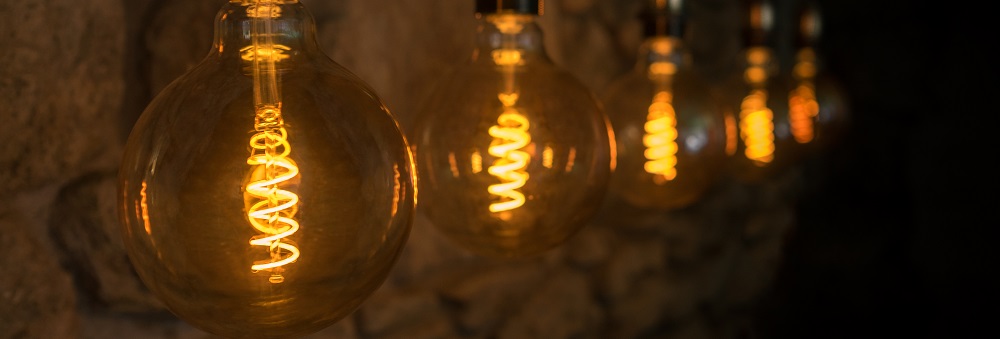
If you are looking to dim classic incandescent bulbs, then you can use a leading edge dimmer. You can find out more about the difference between these in our blog post; Leading Edge Vs Trailing Edge Dimmer. However there is a risk with choosing a leading edge dimmer, and if you decide to switch over to LED at a later date, you will also need to update to a trailing edge dimmer.
How many lights do you need to control?
Switch plates come with different numbers of switches, or gangs. If you have one light in a room, then you only need a one gang dimmer switch, however if you have lots of lights, or you wish to control different lights separately, you should choose more gangs.
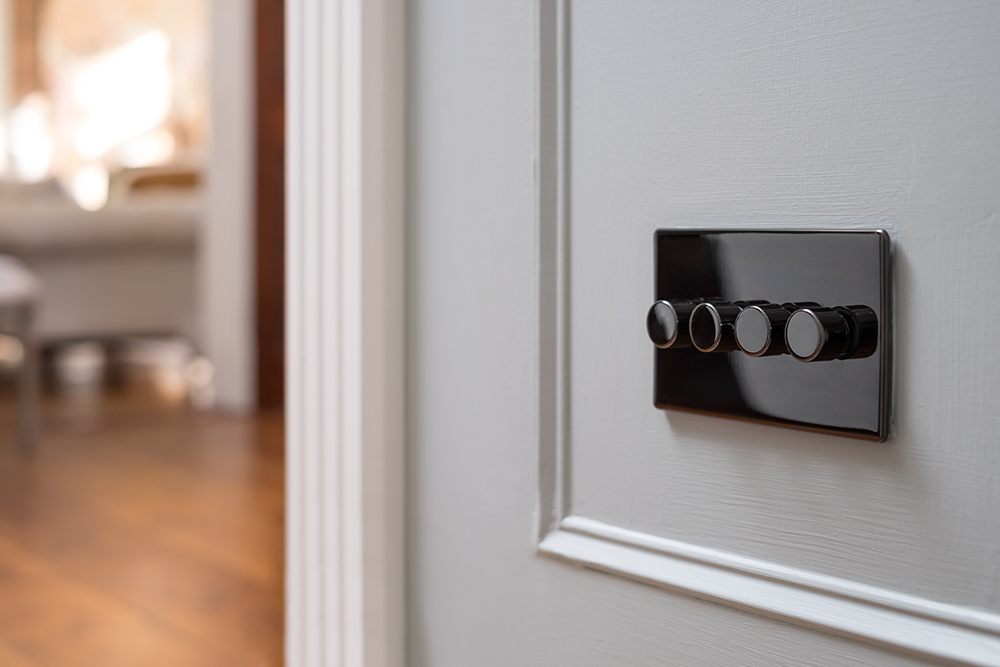
What is the total wattage of the lights you wish to dim?
Dimmer switches generally have a minimum electrical load. This load must be met in order for the switch to operate smoothly. If you have one 8W bulb and a dimmer switch with a minimum load of 10w, then it is likely to flicker or stutter when dimming.
Trailing edge dimmers tend to have a lower minimum load than leading edge dimmers so, as LED bulbs tend to have lower watts than incandescent bulbs, these are better suited for LED.
Switches also have maximum loads, so it is important to keep the load of your lights below the maximum load in order for your lighting to work correctly.
What sort of interior design style do you have?
Dimmer switches, much like other sockets and switches come in a variety of our stunning finishes, and these include brushed chrome, polished chrome, antique brass, brushed brass, black nickel, copper, rose gold and white.
Much like other electrical fittings, it is important to make sure your dimmer switch fits your interior design. You can learn more in our guide to Matching Switch and Socket Finishes to Interior Design Styles.
Can a toggle switch be used as a dimmer switch?
The simple answer is, yes it can! The technology is here and dimming toggle switches are now effectively able to dim lights.Not only does this allow you to choose a style in keeping with your interior design, but including a dimmer toggle has the added benefit of allowing for multi-location dimming.
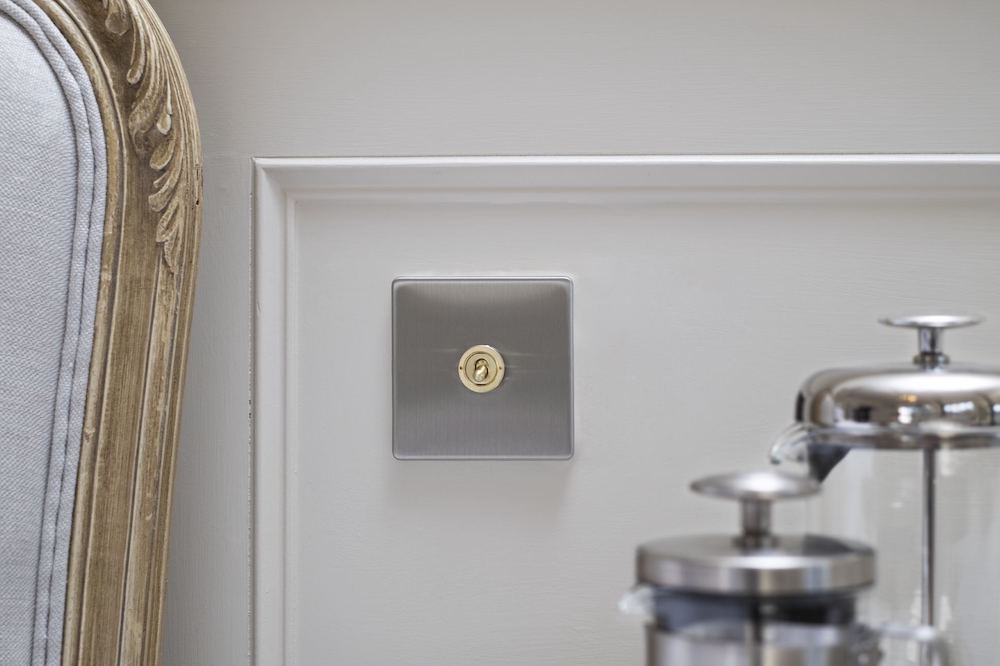
Using a dimmer toggle offers aesthetic as well as functionality. You can control the brightness from multiple points in the room, and this is possible due to the spring action of the switch. By returning to its original resting position, multiple toggle switches can be connected to the same circuit, allowing for each switch to take control when activated by a press or a hold.
We stock dimmer toggle switches in a variety of beautiful finishes, all of which can be found here.
What kind of dimmer switch do I need?
This depends on what function you need your dimmer to perform.
We now stock a range of dimmers from Soho Lighting that uses award-winning Enkin technology, all of which are silent, flicker free, with a simple standardised button setup, and state-of-the-art safety features.
Here’s a quick guide to help you choose the right module.
PDM150 – Standard Dimmer Switch
The PDM150 intelligent dimmer is the solution for most domestic lighting situations, able to handle 150W of LED lighting this standard dimmer is perfect for a moderate lighting setup.
Soft start prolongs the life of your LEDs, and the intelligent software allows to accurately assess the optimum level of power for your lights. A reliable all-purpose dimmer.
PDM400 – High-Capacity Dimmer Switch
If you need a dimmer that can withstand a much larger display, the robust PDM400 has a whopping 400W maximum load, allowing you to dim up to 400W of LEDs without compromising performance, or splitting the load between two or more dimmers.
This is great news for those with complex displays that require dimming from one location. An impressively powerful module.
ZDM150 – Zigbee Smart Dimmer
With smart technology fast becoming the preferred choice in homes, the Zigbee smart dimmer brings control of your lighting setup to the palm of your hand via your smartphone. This smart dimmer also features a wiring option, meaning you can install this dimmer with a toggle switch to utilise multi-location dimming.
Supported by iOS and Android, this clever little module allows you to access several features from your phone, including adjusting brightness, turning the lights on and off, and even pre-set ambient moods for different times of the day. A brilliant, cutting-edge solution to smart lighting.
PDM010 – Specialist Dimmer
The PDM010 1-10V DC dimmer is a robust, high-capacity dimmer that is designed for use with a DC controlled driver and is more suited to specialist or commercial lighting systems.
PDD200 – Dummy Dimmer
While not technically a dimmer, you can opt to match your switches with this dummy dimmer to complete your aesthetic. With a maximum load of 1000W, this dummy dimmer will not adjust the brightness of your lights but matches with other standard dimmers for a more appealing design choice.
[related_products is_auto_added="1"]Dimmer switches allow you to adjust your lighting to the mood, situation, and time of the day. As lighting technology advances, and with developments with LEDs, improvements have been made to dimming. Things such as smoother operation, silent running, and even longevity in LED bulbs. If you are looking for a dimmer switch, you may […]
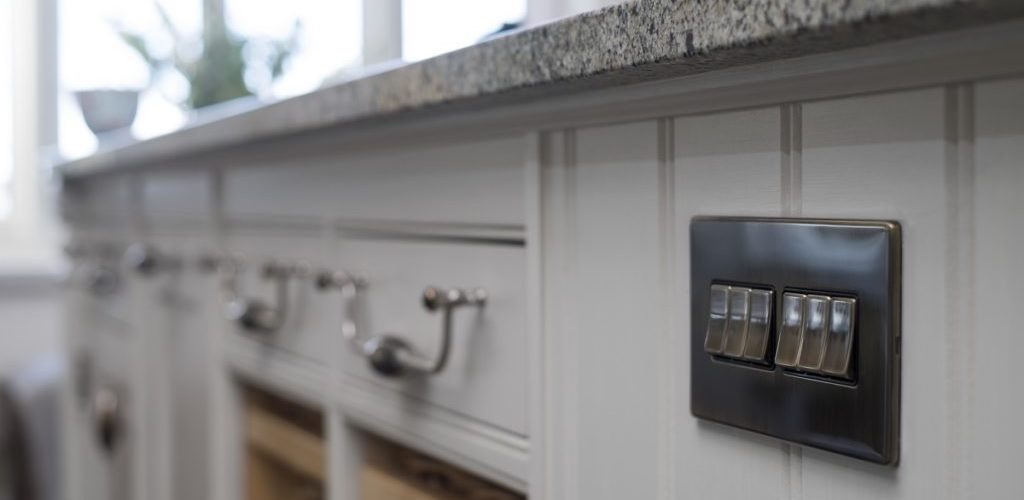
Planning out which sockets and switches you require for your home or project can lead to many different questions around the finish, style, and functionality. In this article, we discuss the difference between single pole and double pole switches and answer some common questions.
Put simply, a switch is a device that is used to control the flow of current within an electrical system. There are two different types of switches: the single pole and the double pole switch.
It’s also important to understand the difference between a pole and a throw as both single and double pole switches can have a different number of throws which change how they work.
What Is A Pole?
The pole of a switch refers to the number of separate circuits that the switch can control. Single pole switches control just one circuit whereas a double pole switch can control two circuits. So a double pole switch is almost like having two single pole switches, controlled by the same switch.
What is the difference between a pole and a throw?
A “Pole” refers to the number of circuits that one switch can control for one operation of the switch. The “Throw” indicates the number of contact points. The two most common types are single-throw and double-throw.
This means you can have four main types of switch configuration which are explained in the diagram below.
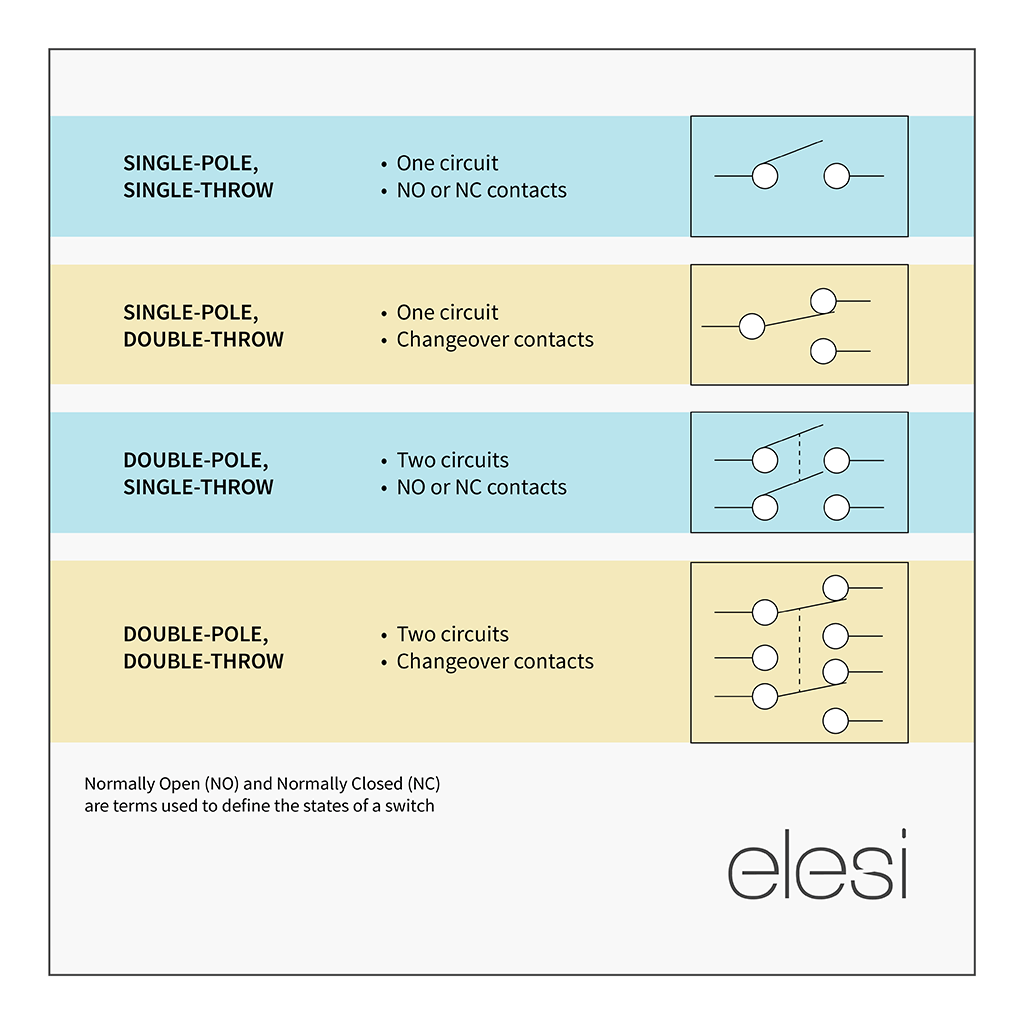
What Are Single Pole Switches?
Standard single pole switches are common, simple light switches. They are used to control one circuit and offer a regular off and on function for things like light fixtures. Most switches in a typical home tend to be single pole, whereas double pole switches are more common in industrial settings.
What Are Double Pole Switches?
A double pole switch controls two separate circuits. These types of switches make it possible to isolate appliances safely.
Double pole switches also tend to be used for appliances with heavy loads like cookers and showers. The wires that feed electricity to double pole switches tend to be larger than the wires that feed to single pole switches, as double pole switches are often used to control 240V circuits. Furthermore, they can be used as a safety shut-off for a residential appliance.
It is important that you check the rating of your product, however, as there are various types of double pole switches. A 20A double pole switch is likely to be only suitable for small ovens, whereas regular ovens are likely to need a 45A DP switch.
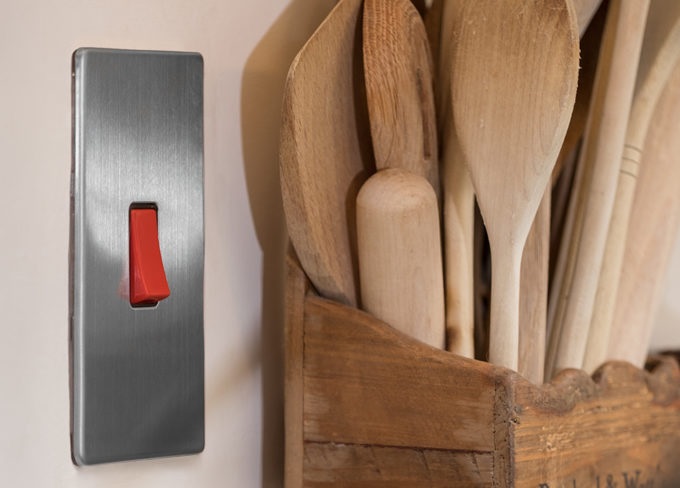
Double pole switches make it possible to isolate appliances safely from the power source. They tend to be used for appliances with heavy loads like cookers and showers. It is important that you check the rating of your product, however, as there are various types of double pole switches. A 20A double pole switch is likely to be only suitable for small ovens, whereas regular ovens are likely to need a 45A DP switch.
When do you use a double pole switch?
Double pole switches are used for appliances that require heavy loads. For example, cookers and showers. Double pole switches can also be used as a safety shut-off for a residential appliance.
Another reason to use a double pole switch is due to regulations that mean you need to have local means of isolation for certain products. So the double pole isolator isolates one particular socket that is behind a fridge for example.
If you are looking to buy sockets and switches, we have two useful guides on choosing the right ones for your home. They include matching switch and socket finishes to interior design styles and switch & socket function and selection.
If you’ve made your mind up then go ahead and browse our collection of double pole switches.
FAQs
A double pole socket switches both the live and neutral to ensure safe isolation of the plugged in appliance.
A double pole switch switches both the live and neutral to ensure safe isolation of the load circuit.
In theory you would only have 1-2 permanent live feeds and 1+ load lives. There are a number of different ways to wire lighting or isolation circuits so there could be a number of different combinations.
A switch module does not require grounding but the yoke and faceplate must always be grounded if the faceplate is made from metal. Most plastic switch plates do not need grounding due to it being a class 2 product.
Whilst a single pole socket is generally cheaper it is always preferred that customers/electricians install double pole sockets for safer isolation of the plugged in appliances.
The difference is simply the amount of poles being switched.
Single pole sockets are perfectly legal and are safe for many appliances, but it is safer to use double pole sockets. Therefore is always better to use double pole sockets in all situations.
Related Categories
[related_products is_auto_added="1"]Planning out which sockets and switches you require for your home or project can lead to many different questions around the finish, style, and functionality. In this article, we discuss the difference between single pole and double pole switches and answer some common questions. Put simply, a switch is a device that is used to […]
When planning which sockets and switches you need for each room in your home, you may have come across intermediate switches. We are often asked what intermediate switches are, so in this article we explain what they are, where you may use them and how to choose the right one.
Intermediate switches are three way switches, for when you have three or more switches controlling one light. The middle switch of the three needs to be an intermediate switch.
Where would you use an intermediate light switch?
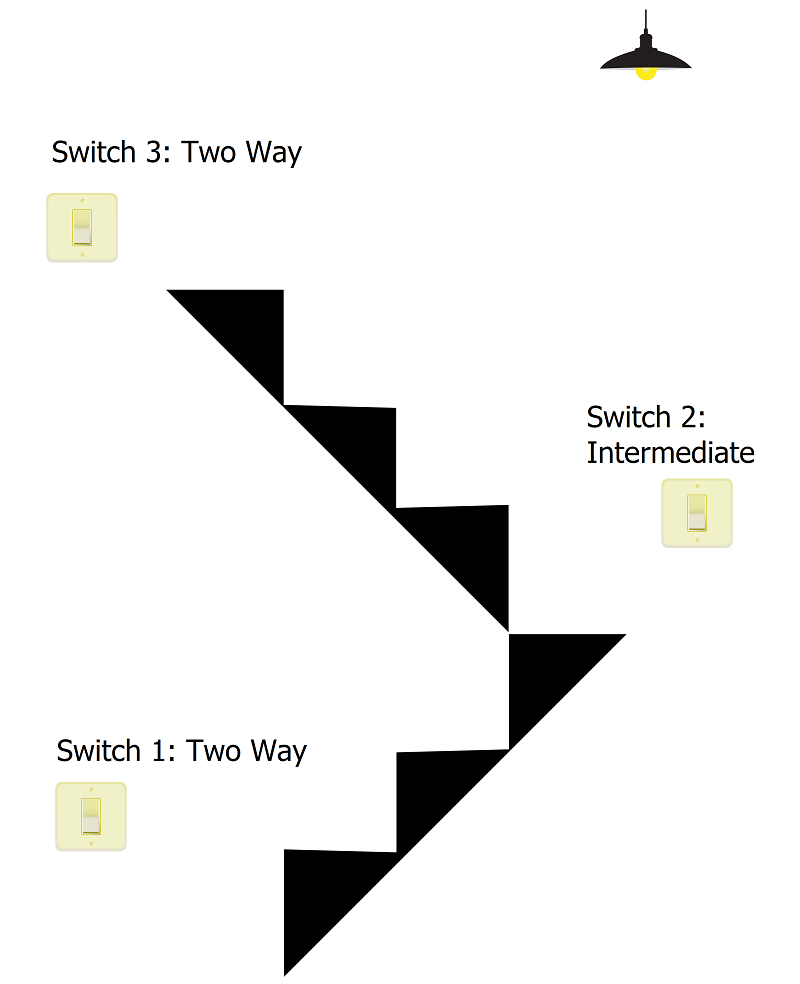
Other switches available are one way and two way switches. One way switches would be use if you only have one switch for a light.
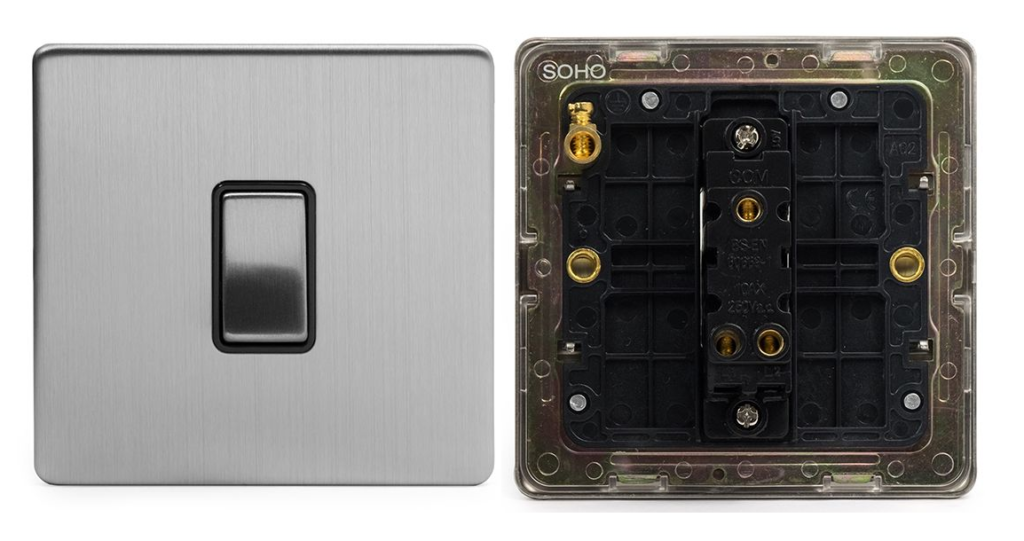
Two way switches can be used as a substitute for a one way switch, but also when there are two switches for one light. So if you have a room with two doors and need a switch at each door for the same ceiling light, two two way switches are needed. Intermediate switches can cover this but two way switches will do the job.

Intermediate switches can be used for most lighting circuit situations, but as they are more expensive than 2-way switches, are generally only used when needed. If you have a big room with three doorways, and a switch at each doorway, all controlling the same ceiling light, you’ll need a 2 way switch at each end doorway and an intermediate switch in the middle, so the circuit can function properly.
Why do intermediate switches cost more?
Intermediate switches are simply more complicated than one way or two way switches, so they tend to cost more.
What sort of intermediate switches are there?
These switches are available commonly as rocker switches, especially as one gang intermediate switches, however a few socket and switch manufacturers including Soho Lighting provide intermediate toggle switches. Soho Lighting and Lieber also sell 2 gang, 3 gang and 4 gang intermediate rocker switches.
Grid switches can be used to create combinations too. You may want to have a two way switch and an intermediate switch on the same plate. This can be created by attaching a two way switch module and an intermediate switch module to a grid frame.
Intermediate Dimmer Switch
Intermediate Dimmer Switches are now available. Not only is the technology now available for a true multi-way dimmer, but the Dimming Toggle Switch from Soho Lighting is a great, design-conscious choice for multi-location dimming. Smart Switches are another great option for multi-location dimming, and add the extra benefit of remote control of your lighting.
[related_products is_auto_added="1"]When planning which sockets and switches you need for each room in your home, you may have come across intermediate switches. We are often asked what intermediate switches are, so in this article we explain what they are, where you may use them and how to choose the right one. Intermediate switches are three way […]
Stylish and slick, a Black Nickel finish lends understated sophistication to downlights, sockets and switches.

The smooth metallic or matt black finish and soft shine looks stunning in a contemporary interior and perfectly complements assets such as black furniture items or smaller accessories like kettles and Televisions. Quality Black nickel sockets and switches tend to look aesthetically superior when compared to the more simple matt black plastic or metal electrical outlets. Ensuring high quality when selecting products in this finish is essential, especially when a poorly produced black nickel finish can look ‘cheap’ and damage the look are you wishing to create. The price of sockets and switches in this finish can vary significantly with lower priced versions stamped with visible screws, lacking in depth of the shine and looking a little ‘plastic’ as a result. A small increase in cost can secure a luxury, screwless product with sumptuous sheen that exudes quality beyond the price point.
What is black nickel?
Black nickel is an alloys of nickel, zinc and sulphide. It is often plated onto other metals to give a dense black, finish. It can be seen on many different products including door, window and kitchen furniture, hand rails, musical instruments and more. It can either have a matt finish or more of a polished / gloss finish.
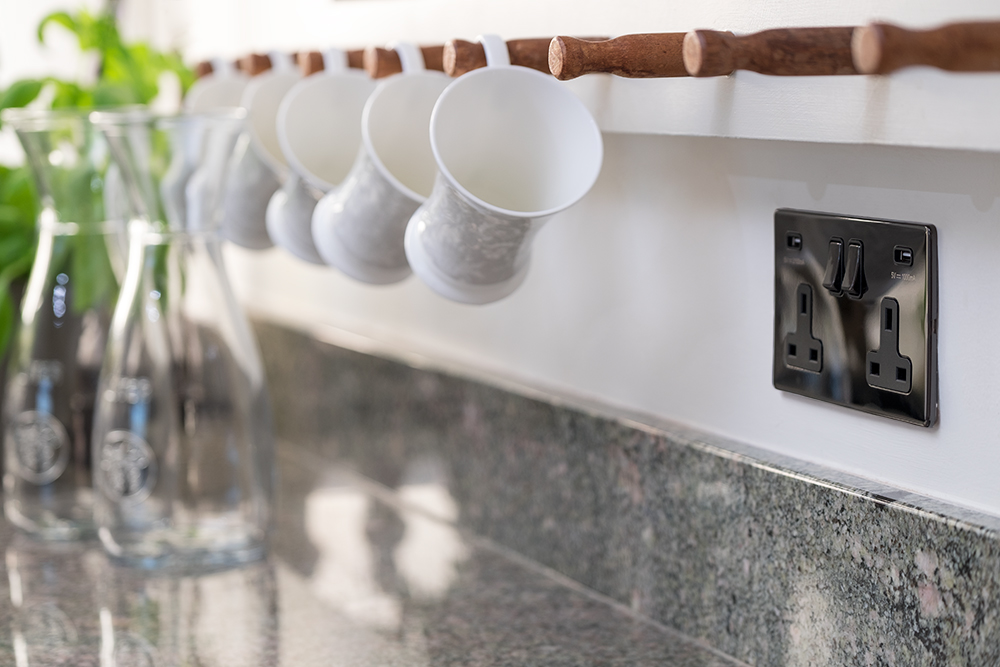
What colours go well with black nickel?
Choosing a socket and switch finish that goes well with the rest of your décor and the colours around the room is important. Black is a very universal colour that can sit beautifully alongside pretty much any other colour, however black nickel has a level of versatile sophistication beyond that of black plastic. When choosing downlights or sockets and switches in this finish, classic wall colours in shades of white or grey give a clean and slick contemporary look, however this finish also looks sensational against vivid colour, such as a deep rich red, hot pink or bold orange. Black Nickel is not solely for contemporary interiors and can be used to great affect with period styles such as art deco, so celebrated for its striking blends of black and white colour.
Choosing black nickel
There are plenty of opportunities to accent your interior with this exquisite finish; black nickel sockets and switches, downlights, door, kitchen and window furniture, as well as taps to name just a few.
FAQs
Yes, we have black nickel bulb holders, and a range of black nickel downlights.
Stylish and slick, a Black Nickel finish lends understated sophistication to downlights, sockets and switches.
One of the more common metallic finishes around at the moment, brushed chrome is versatile, effortlessly fitting into any décor style. This is a popular finish for not only sockets and switches, but also downlights, door handles and kitchen accessories like kettles and toasters. If you are considering changing the electrical outlets in your home or business and are looking to use brushed chrome brushed chrome sockets & switches, this article will tell you everything you need to know before making the final decision.
What is brushed chrome?
Chrome is a silvery, reflective metal that is commonly used across a number of products including cars, motorbikes, home electrics and musical instruments, to name a few. It looks similar to nickel, but has a slightly blue shine, compared to the whitish, almost yellow appearance of nickel. When it comes to home electrical items like sockets and switches, and downlights, these finishes can both be used in the same way.
Chrome finishes can differ in a number of ways, but the most common options are brushed chrome, polished chrome and satin chrome. For a more detailed look at the differences between brushed and polished, see our article Brushed Chrome Vs Polished Chrome.
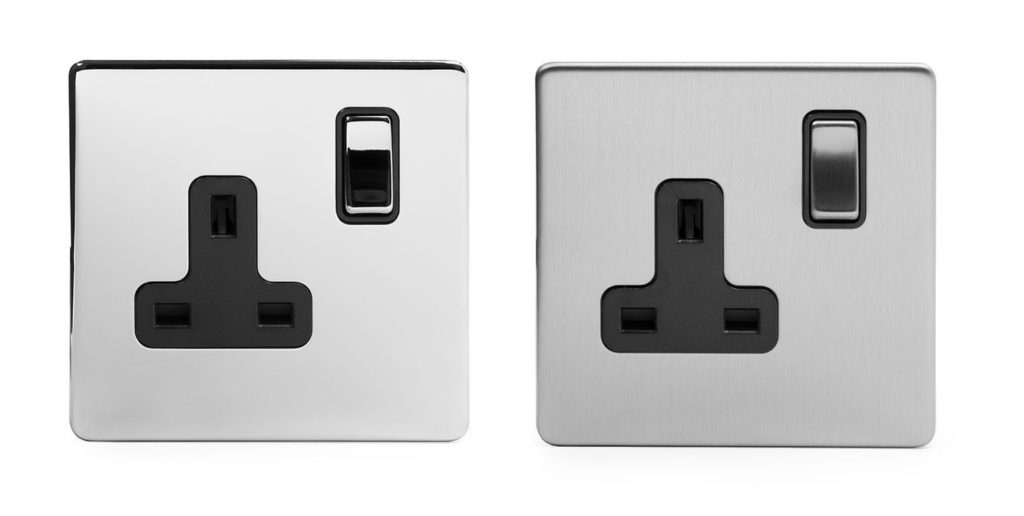
Polished chrome is exactly as expected, a polished, smooth finish of chrome that creates a mirror-like surface (in fact, polished chrome sockets and switches are occasionally known as mirror chrome sockets and switches). This is very similar to silver.
Satin chrome and brushed chrome are generally very similar, but brushed chrome always has the finish of brush lines across the product. Some satin chrome products have more of a matt appearance, but without the brush marks. Brushed chrome should look like a chrome finish, which has been brushed.
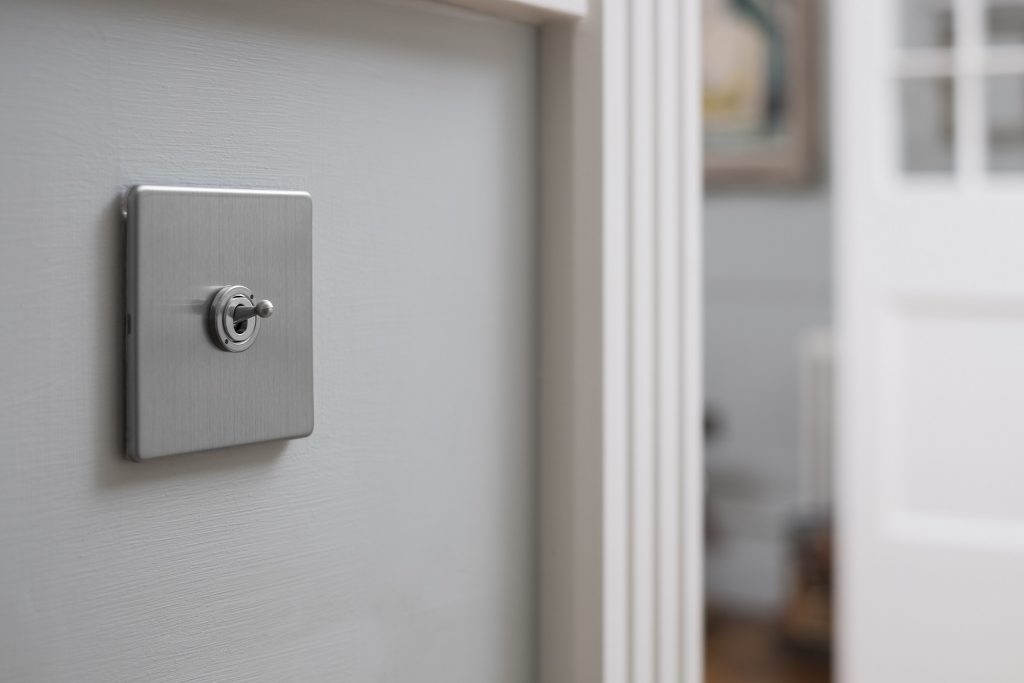
The Benefits of Brushed Chrome Sockets & Switches
There are plenty of reasons to choose brushed chrome over other finishes. Chrome’s versatility has to be at the top of the list. If you decide to change your décor style in future, it’s likely that chrome will still fit in. Something like antique brass may look out of place in a contemporary setting, and white plastic or black nickel could look strange in a traditional or classic style room, but chrome will look good alongside most styles.
One of the main negative points of polished chrome is that it can pick up fingerprints and blemishes very easily. This may not be so important for downlights or other fittings that aren’t handled often, but for features that are touched every day like door handles and light switches, the finish can quickly look grubby so needs to be cleaned often. Brushed chrome covers up these marks.
What Colours Work Especially Well with Brushed Chrome Sockets and Switches?
The good news is that chrome generally works with most colours, so suits a lot of walls and furniture. There are, however, a few colours that work especially well. Black and white are the simples and safest choices, but also try chrome alongside navy blue or burgundy. Most blue shades do work well with brushed chrome sockets and switches, as does cream or an off-white paint.
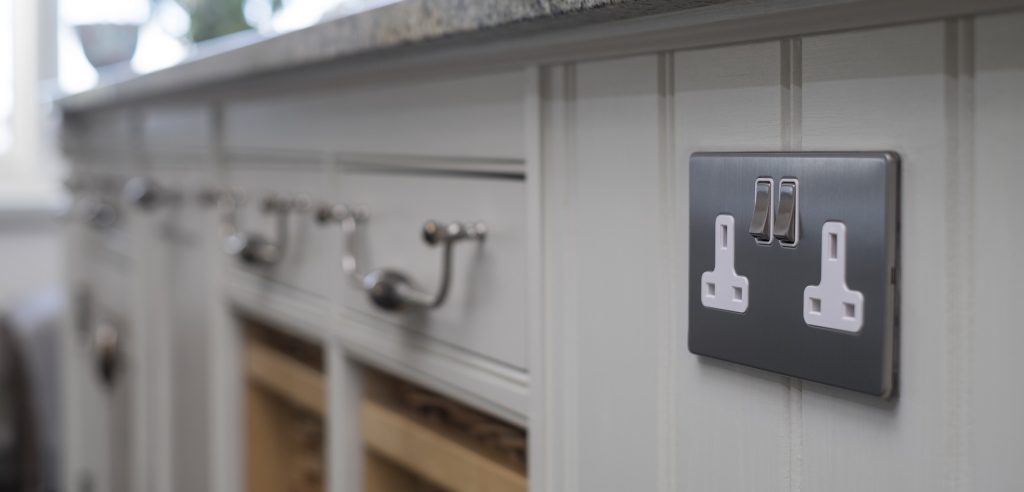
Choosing the Right Range
This is the most important pointer. There are plenty of different ranges of brushed chrome sockets and switches to choose from at various levels of price and quantity. This is a finish that is very quantity-sensitive, as cheap brushed chrome sockets and switches really do look cheap. Whether you choose to go for a cheaper style or choose to spend more for higher quality, the size of the range is key.
Decide what sort of sockets and switches you need based on the required functionality. Do you need simple rocker switches, or do you need to dim your bulbs? Is a USB socket needed or simply regular plus sockets? Do you have floor lamps that you want to be on the lighting circuit, so require 5amp sockets? You can read more in our article: Switch & Socket Function & Selection – What do I need? Once you know what you need, it is best to find a range that covers all of that. Most ranges differ slightly, so adding in sockets or switches from different brushed chrome ranges can look messy.
Some manufacturers have euro module options as well as grid switches. Grid switches provide a really attractive and easy way to add bespoke switches to your room. Euro modules offer more options like this but tend not to look quite as good as the sockets in the range.
Both nickel and chrome have similar appearances, and can often look the same in photographs. Nickel tends to have a slightly more yellow and deeper appearance than chrome, and chrome (especially polished chrome) can have more of a blue tone to it.
Browse our selection of brushed chrome sockets and switches.
Browse Categories
One of the more common metallic finishes around at the moment, brushed chrome is versatile, effortlessly fitting into any décor style. This is a popular finish for not only sockets and switches, but also downlights, door handles and kitchen accessories like kettles and toasters. If you are considering changing the electrical outlets in your home […]
Two lighting, socket and switch finishes that have come into fashion in recent years are rose gold and copper. These have slightly similar appearances, but the subtle differences really make them suitable for different décor styles.
Rose gold and copper both bring a beautiful colour in to the room, without overpowering the surroundings. They can both reflect a soft light, for a calming atmosphere and can create elegance. You may be unsure which finish to go for, so in this article we look at the differences between them both.

What is copper and what is rose gold?
The key difference between the two from a scientific perspective is that rose gold is an alloy, meaning it is a mixture of other metals, whereas copper is a native metal- a metal that is found in its metallic form in nature. Other examples of native metals are gold and silver.
The reason why rose gold looks similar to copper is that copper is actually in rose gold. The exact composition values tend to vary, but rose gold is made up of copper, yellow gold and silver. You may have seen some rose gold jewellery, lighting or electrical fixtures that look more copper-coloured than others. This is because they are likely to have a higher copper to yellow gold ratio.
Rose gold tends to have more of a yellowish/golden colour to it (due to the yellow gold). Copper has a beautiful reddish/pink shine to it.
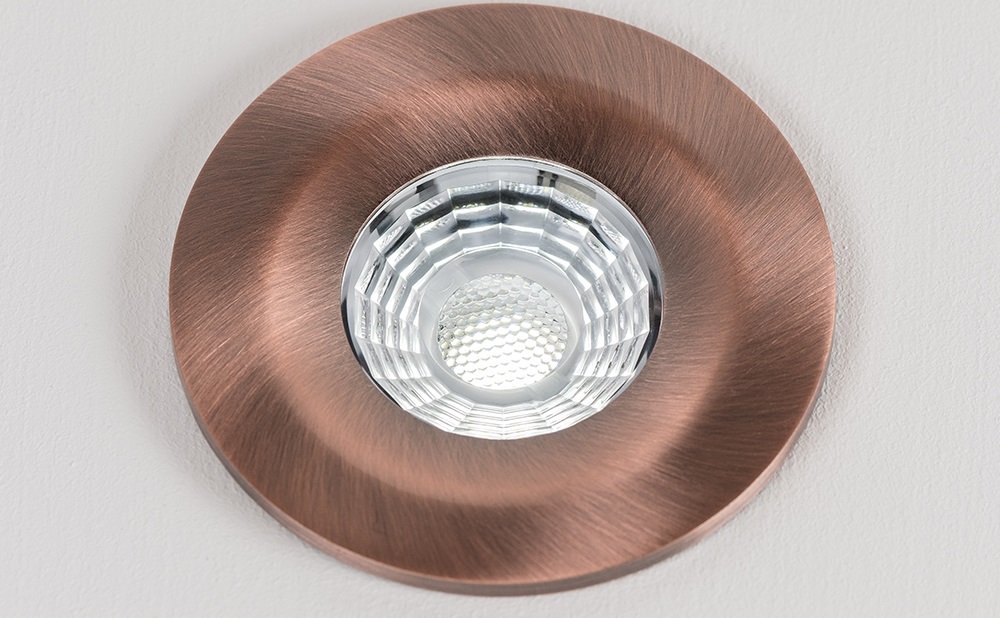
Where to use rose gold or copper
In some situations and decors, you can switch out rose gold and copper. However, it is generally better to stick to one or the other. For example, if you have rose gold downlights, then it is best to use rose gold pendant lights too, rather than copper pendants.
Rose gold has more of a contemporary or modern feel to it, and blends well with soft, pastille colours (read more in our article: Lighting, Sockets & Switches: What is Rose Gold Finish?) whereas copper fits in perfectly with industrial style surroundings. Copper can fit into contemporary surroundings too, but adds a hint of classic or industrial to them.
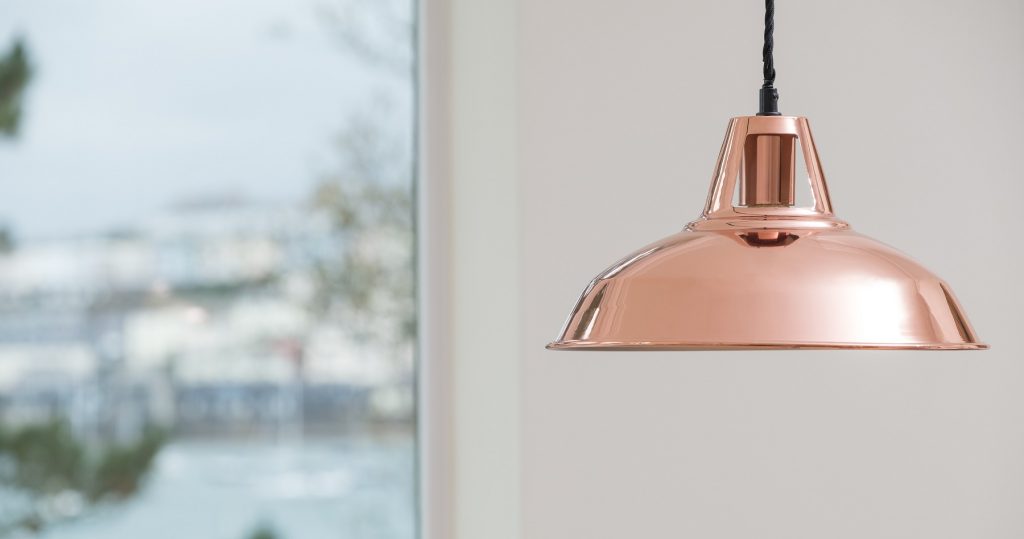
Both rose gold and copper work well alongside soft or dark blues, blacks and greys. Rose gold, especially works well with glass.
If you have copper kettles or pans in your kitchen, be sure to choose copper light fittings and sockets and switches. The same goes for rose gold- rose gold toasters and kettles have become popular, and look even better if your kitchen is equipped with rose gold downlights, pendants, sockets and switches. The key is to get a consistent feel through the room as these finishes could clash with other finishes like chrome if situated too close.
Lighting
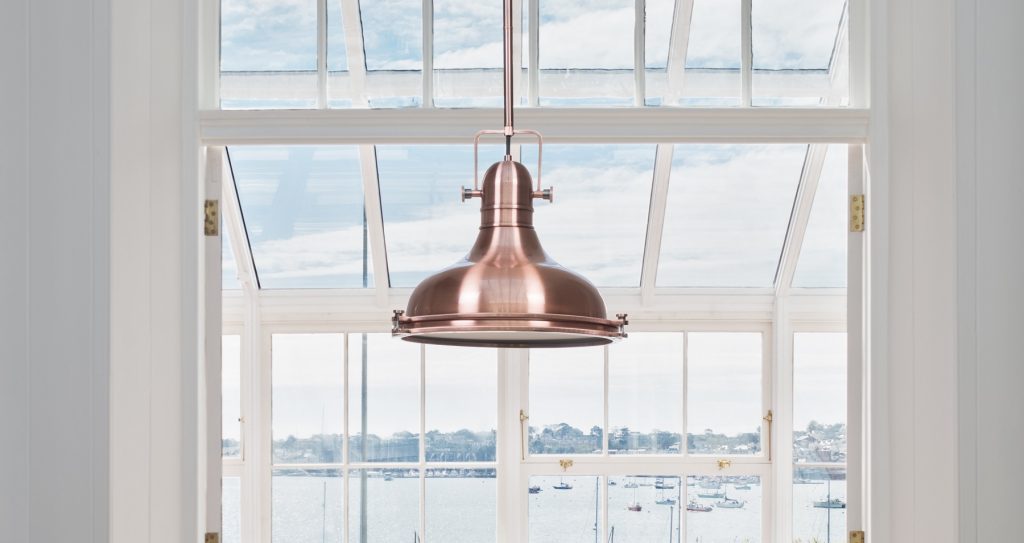
Both rose gold and copper light fittings can bring elegance and style to the room and can really create a centrepiece. They also have the added benefit of reflecting colour to their surroundings. As you can see, these types of lights have an industrial style, but wouldn’t look out of place in a more modern kitchen or living room, or perhaps in a classic style hallway.
Browse our selection of rose gold pendant lights, rose gold downlights and copper downlights.
[related_products is_auto_added="1"]Rose gold and copper have slightly similar appearances, but the subtle differences really make them suitable for different décor styles.
Black nickel is one of the most stylish finishes for sockets and switches available. It works perfectly with contemporary style decors and alongside black appliances like TVs, kettles and computer equipment. While it has a slightly more complex appearance than regular matt black finish, which makes it look more expensive, the same can also be said for black chrome finish, which tends to look very similar.
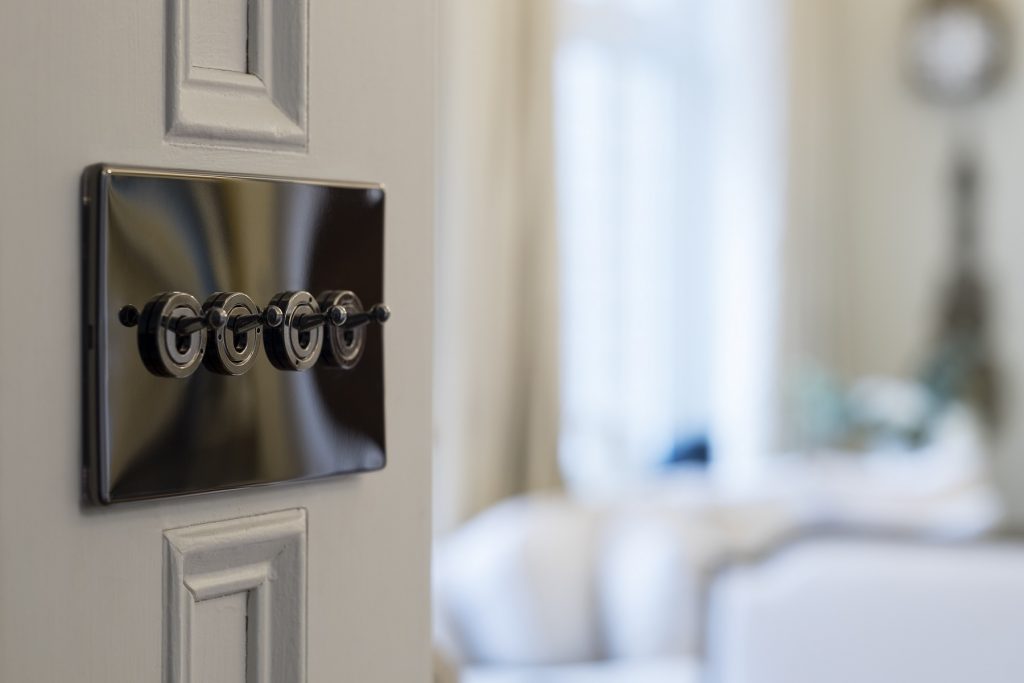
Black Nickel VS Black Chrome
You may have seen black chrome sockets and switches or downlights. This finish is simply chrome with a black tint; and black nickel is nickel with a black tint. Not all black nickel sockets and switches look the same, as some have a shiny, polished appearance, with others carrying a matt or satin finish. The latter often runs the risk of looking cheaper, especially on cheaper electrical fittings.
Whilst black chrome and black nickel look very similar, there are slight differences between chrome and nickel which subtly change the appearances.
What is black chrome?
Chrome plating gives the metal and slightly blue shine, and nickel has a softer, burnished appearance. With the black versions of these finishes, however, it is very difficult to tell them apart.
What is black nickel?
Black nickel has a black tint on a nickel finish. A polished nickel finish is mirror-like but with a silvery tint, black nickel gives is darker. Essentially, it is a black, mirror-like finish and can go well with black TVs, kettles and toasters.
Black nickel sockets tend to be far more common than black chrome sockets. As these finishes are so similar, it is common to simply go for the more available black nickel finish. When it comes to downlights, however black chrome downlights are far more common. These, much like socket and switch finishes, are very difficult to distinguish between, as the less common black nickel downlights look very similar.
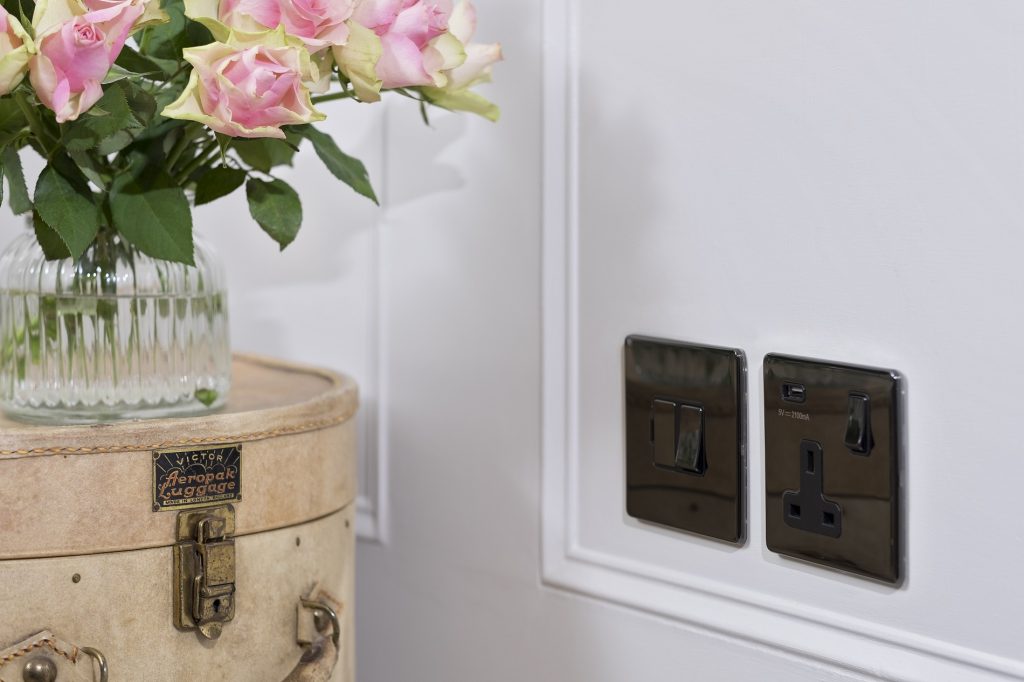
Whether you are looking for black chrome sockets and switches or black nickel sockets and switches, it is important that you choose a collection that is well made, robust and well finished, as black nickel/chrome is a finish that can really suffer if the quality is poor. Cheaper black nickel sockets, even if metal, can have a plastic appearance and can spoil the overall appearance of the room.
FAQs
Black nickel tends to be shiny, unless otherwise stated. Most black nickel finishes will be polished, rather than satin or brushed.
Black nickel has a black tint to it, so it goes well alongside other black items like TVs, black kettles and toasters.
Gunmetal is a variety of bronze. Modern gunmetal tends to be composed of copper, tin, and zinc. Gunmetal is a shade of grey that has a bluish purple tinge. Black nickel however is not grey, but black.
Shop for black nickel sockets & switches or black nickel downlights at Elesi.
Shop for Black Nickel
[related_products is_auto_added="1"]Black nickel is one of the most stylish finishes for sockets and switches available. It works perfectly with contemporary style decors and alongside black appliances like TVs, kettles and computer equipment. While it has a slightly more complex appearance than regular matt black finish, which makes it look more expensive, the same can also be […]
